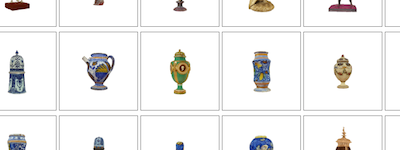
17.06.2010 Uncategorized
Thomas was the first to discover the mobile webgl support on the N900 and Yvonne was brave enough to patch her phone with the latest firmware-upgrade which includes support for WebGL.
Not everything works (e.g. not the AR-Demo ) but at least some examples, including the dancing Dr. B, works on the phone. Even with animation and sound. Quite impressive! Now all we need is webgl support on iOS devices.
15.06.2010 Showcase
New example which uses an paraview-export in combination with html-events for picking. The actual method will change the next days but it shows already how this could work.
More example and a simple tutorial for paraview-exports are coming very soon.
18.05.2010 Showcase
Not yet hosted somewhere but coming soon. A Facebook app utilizing x3dom to visualize your friends network in 3D.
There is only a video right now but will be released soon. Developed by Nikitia Matter from the University of Bielefeld.
25.03.2010 Release
First stable release of the framework.
http://x3dom.org/x3dom/release/x3dom-v1.0.js
All initially planned features are implemented:
The proposed HTML profile is partially implemented:
The fallback-model is also only partially implemented:
Next release (v1.1) will focus on the following topics:
Uncategorized
The ever growing interest in Augmented Reality (AR) application makes it an important scenario for a generic web-based 3D framework. However, there is a main problem. Web-Browsers (UA) /HTML does not provide any API to read the pixels of your attached video-camera.
Until now there were only two generic options to overcome this problem: Utilizing a specific AR-plugin (fast, but with all plugin issues) or Flash-based. Flash is also a plugin but installed on more than 90% of all UA and can read the pixels directly.

But pure Flash-based AR-solutions have one major drawback. Flash has no API to access the GPU directly for 3D rendering. Therefore all 3D-render libs are limited (e.g. polygon-count and shading feature) compared to some hardware accelerated solutions (e.g. WebGL).
We use in this tutorial and Demo a Flash-based tracker (which processes all camera-pixels) and create the 3D-overlay with X3DOM. The result is quite impressive. Really fast AR-apps, without any plugin (besides Flash) and a very simple production pipeline.
23.03.2010 Uncategorized
The X3D Profile (not just WebSG) supports now explicit GLSL shaders utilizing the X3D Shaders component. The example uses multiple textures (diffuse, normal and env) and generic VertexAttribute containers to feed the render backend.

Support for the X3D Shaders component allows mixing shader-based materials with declarative mesh content.
17.03.2010 Uncategorized
A bunch of new X3D nodes like LOD, Switch, PointSet, IndexedTriangleSet and ComposedShader as well as new functionality like the sky-box background and a more complete DOM-event handling have been implemented for the first release.
A dynamically generated list of all X3D nodes and components can be found here. If you are interested in the node interface or full specification just click on the respective node or component.
Uncategorized
To improve performance and precision, picking (i.e. the onclick event) now uses a render-buffer-based approach (as shown in the screenshot below) instead of a scene traversal with standard bbox-based intersect tests.
09.03.2010 Uncategorized
The InstantReality X3D exporter for 3dsMax can now directly export to HTML/XHTML. Daily beta builds are now available for Windows XP, Windows Vista and Windows 7 32 and 64 Bit. The package contains versions for Max 2008, 2009 and 2010.
ftp://ftp.igd.fraunhofer.de/outgoing/irbuild/InstantExport/
Bugs should be reported in the instantReality forum:
Uncategorized
First application prototype tutorial online. A very simple car configurator, which shows how to change the color or texture of a 3d model with simple HTML/JavaScript setAttribute calls. More examples will come very soon.
Uncategorized
First tutorial which shows how to get your data converted to X3Dom is online. More will come the next days.
20.01.2010 Uncategorized
The instantReality transcoder is an online tool to recode your X3D data. It can read classic (VRML style) and XML and can produce classic (VRML), X3D and now HTML and XHTML with embedded X3DOM code.
Showcase
Another external showcase. The 3D-Coform Consortium uses X3DOM to visualize 3D reconstruction and scanning results.

3D-Coform data
Nice showcase which uses jquery-Lightboxes to popup the 3D-Viewer.
19.01.2010 Showcase
The wowmodelviewer includes now code to export static and animated X3D models.
You can even export directly to an XHTML/X3DOM page which includes the X3D model.
No direct content link but a nice video: http://www.youtube.com/watch?v=16P6_e7VUmw
18.01.2010 Showcase
External Showcase from Wolfram Kresse.
It’s a Solor System Simulation. Very nice. More feature coming soon.
14.01.2010 Uncategorized
We finally managed to add a generic handler, which works in all browsers, to monitor appends and removes of DOM nodes. This allows you to add/remove nodes via simple DOM commands. Example is online
07.01.2010 Uncategorized
Following the discussion on the WebKit forum it looks unlikely that the DOMAttrModified bug will be fixed soon. We implemented therefore a really ugly workaround (overwriting the setAttribute() method). Hopefully the WebKit peoply will come up with some better DOM-Mutation monitoring method soon.
However, thanks to this bugfix, the Dom Manipulator Example work now in WebKit and Chrome.
Uncategorized
We now support HTML and XHTML explicitly. There are two basic examples now: HTML without xml-namespace and lower-case and XHTML with xml-namespace and case sensitive node-names/elements.
10.12.2009 Uncategorized
x3dom works with the latest Google Chrome dev-channel version. Same WebKit Dom Level 2 bug but it’s really fast.
24.11.2009 Uncategorized
On the way to better HTML5 integration: We added support and example for mixed Uppercase, lowercase and CamelCase elements. You can even use different encodings for the same node-types. Support for mixed-case attributes is coming soon.